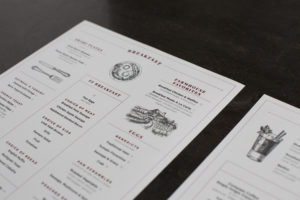A restaurant’s menu design is the first piece of branding your guests will see. Sure, menu design trends come  and go, but the importance of menu design never goes out of style.
and go, but the importance of menu design never goes out of style.
Whether you’re a restaurant that’s just starting up or working to reposition an existing restaurant concept, one of the first tasks you should tackle is to focus on quality restaurant menu development that speaks to who you are as a brand. Approach this piece as a showcase in setting the stage for your brand: the tone, your voice, logo & design aesthetic, and of course, your restaurant’s food & beverage focus.
Last time, we covered what we saw as the best menu design trends for 2019. From the broad strokes of focused F&B content to personalization, we covered menu design concepts. Now, we are expanding upon trends to highlight our Great Restaurant Menu Design Ideas to Consider that can have a real impact on your overall restaurant brand strategy to engage, educate, inspire, and yes, impress your guests.
- Play on Color. Look around your space (or at your mood boards) and play up the colors of your brand. A great way to tie this first-look piece into your overall branding is playing upon your color scheme.
- Put Stock in Paper. Gather a good amount of paper stock samples for your team to see, feel, and vote on. Again, the goal here is to have your brand concept translate.
- To Cover or not to Cover. Explore the idea of adding an interesting cover to your menu design. You want a menu that is durable, but still fits your aesthetic.
- Focused Features. Do you want to feature original artwork or tactile elements, such as photography or raised font(s)? Images and unique design features can add interest and are worth exploring how they could fit within your concept while adding another dimension to your menu design.
- Partner Showcase. Connect your guests to the purveyors and suppliers you work with to add a layer of transparency. Introduce a quote from your source speaking to your shared partnership and mission.
- Impress Your Guests. Add a concise, strategic line (or two) to fit within your menu design style, highlighting your restaurant’s key points. What drives your business? What are your top 3 selling points? Who are you as a brand?
- Food for Thought. Craft a seasonal extension of your menu with a clip-on card speaking to chef picks, seasonal ingredient features, dish inspiration, and the like. The goal here: to engage with and encourage guests to try something new.
- Story Tell. Here, authenticity speaks volumes. Tell the story behind your brand or behind a section of your menu. Is your pasta inspired by your grandmother’s cooking? Say so. Have you crafted a special sauce for your burgers or sandwiches? Say so. Is there a great story behind why you named a certain cocktail or how you discovered the maple syrup you serve? Tell it. Authenticating your brand and connecting it to guests is a win-win for your business.
